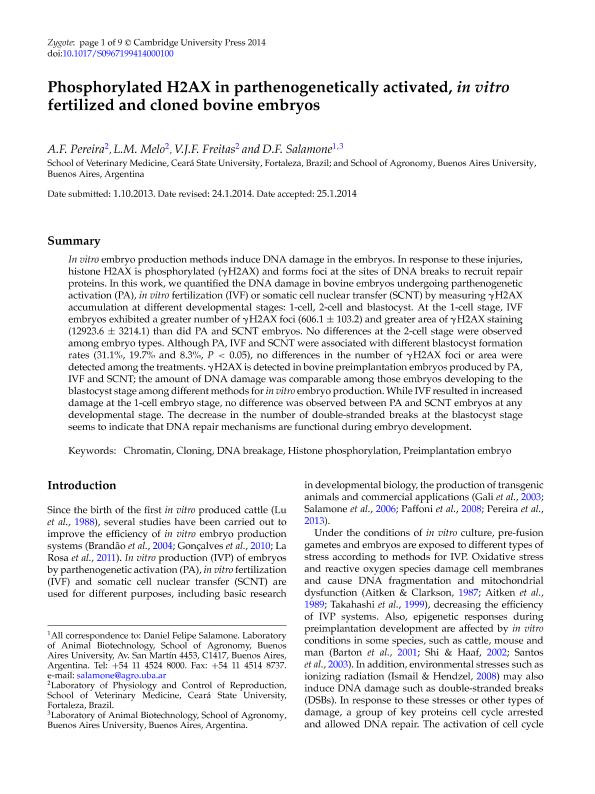Mostrar el registro sencillo del ítem
dc.contributor.author
Pereira, A. F.
dc.contributor.author
Melo, L. M.
dc.contributor.author
Freitas, V. J. F.
dc.contributor.author
Salamone, Daniel Felipe

dc.date.available
2017-05-09T18:36:49Z
dc.date.issued
2015-08
dc.identifier.citation
Pereira, A. F.; Melo, L. M.; Freitas, V. J. F.; Salamone, Daniel Felipe; Phosphorylated H2AX in parthenogenetically activated, in vitro fertilized and cloned bovine embryos; Cambridge University Press; Zygote; 23; 4; 8-2015; 485-493
dc.identifier.issn
0967-1994
dc.identifier.uri
http://hdl.handle.net/11336/16154
dc.description.abstract
In vitro embryo production methods induce DNA damage in the embryos. In response to these injuries, histone H2AX is phosphorylated (H2AX) and forms foci at the sites of DNA breaks to recruit repair proteins. In this work, we quantified the DNA damage in bovine embryos undergoing parthenogenetic activation (PA), in vitro fertilization (IVF) or somatic cell nuclear transfer (SCNT) by measuring H2AX accumulation at different developmental stages: 1-cell, 2-cell and blastocyst. At the 1-cell stage, IVF embryos exhibited a greater number of H2AX foci (606.1 ± 103.2) and greater area of H2AX staining (12923.6 ± 3214.1) than did PA and SCNT embryos. No differences at the 2-cell stage were observed among embryo types. Although PA, IVF and SCNT were associated with different blastocyst formation rates (31.1%, 19.7% and 8.3%, P < 0.05), no differences in the number of H2AX foci or area were detected among the treatments. H2AX is detected in bovine preimplantation embryos produced by PA, IVF and SCNT; the amount of DNA damage was comparable among those embryos developing to the blastocyst stage among different methods forin vitro embryo production. While IVF resulted in increased damage at the 1-cell embryo stage, no difference was observed between PA and SCNT embryos at any developmental stage. The decrease in the number of double-stranded breaks at the blastocyst stage seems to indicate that DNA repair mechanisms are functional during embryo development.
dc.format
application/pdf
dc.language.iso
eng
dc.publisher
Cambridge University Press

dc.rights
info:eu-repo/semantics/openAccess
dc.rights.uri
https://creativecommons.org/licenses/by-nc-sa/2.5/ar/
dc.subject
Fertililización in Vitro
dc.subject
Clonación
dc.subject
Partenogenesis
dc.subject
Histona H2ax
dc.subject.classification
Tecnología GM, clonación de ganado, selección asistida, diagnósticos, tecnología de producción de biomasa, etc.

dc.subject.classification
Biotecnología Agropecuaria

dc.subject.classification
CIENCIAS AGRÍCOLAS

dc.title
Phosphorylated H2AX in parthenogenetically activated, in vitro fertilized and cloned bovine embryos
dc.type
info:eu-repo/semantics/article
dc.type
info:ar-repo/semantics/artículo
dc.type
info:eu-repo/semantics/publishedVersion
dc.date.updated
2017-05-08T21:18:09Z
dc.identifier.eissn
1469-8730
dc.journal.volume
23
dc.journal.number
4
dc.journal.pagination
485-493
dc.journal.pais
Reino Unido

dc.journal.ciudad
Cambridge
dc.description.fil
Fil: Pereira, A. F.. Universidade Estadual Do Ceara; Brasil
dc.description.fil
Fil: Melo, L. M.. Universidade Estadual Do Ceara; Brasil
dc.description.fil
Fil: Freitas, V. J. F.. Universidade Estadual Do Ceara; Brasil
dc.description.fil
Fil: Salamone, Daniel Felipe. Universidad de Buenos Aires. Facultad de Agronomía. Pabellón de Zootecnica. Laboratorio de Biotecnología Animal; Argentina. Consejo Nacional de Investigaciones Científicas y Técnicas; Argentina
dc.journal.title
Zygote

dc.relation.alternativeid
info:eu-repo/semantics/altIdentifier/doi/http://dx.doi.org/10.1017/S0967199414000100
dc.relation.alternativeid
info:eu-repo/semantics/altIdentifier/url/https://goo.gl/sxNeSA
Archivos asociados
